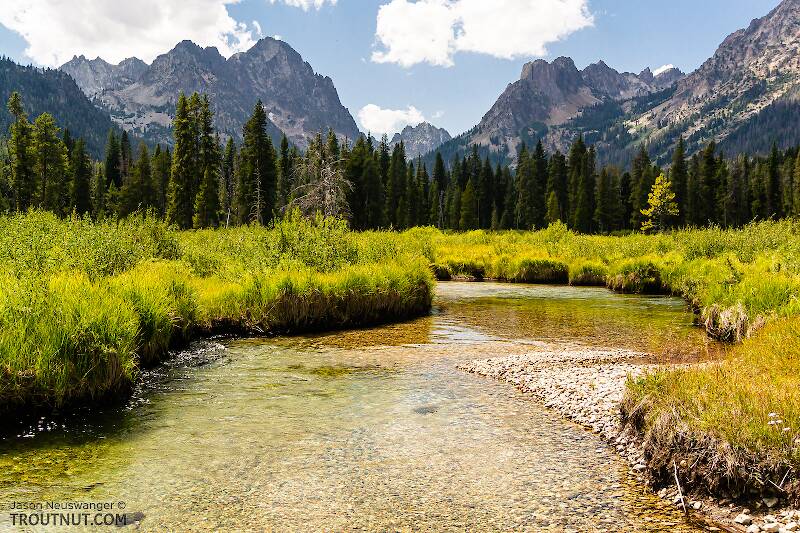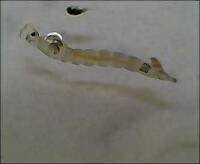
Hex Mayflies
Hexagenia limbata
The famous nocturnal Hex hatch of the Midwest (and a few other lucky locations) stirs to the surface mythically large brown trout that only touch streamers for the rest of the year.
Featured on the forum

Nymphs of this species were fairly common in late-winter kick net samples from the upper Yakima River. Although I could not find a key to species of Zapada nymphs, a revision of the Nemouridae family by Baumann (1975) includes the following helpful sentence: "2 cervical gills on each side of midline, 1 arising inside and 1 outside of lateral cervical sclerites, usually single and elongate, sometimes constricted but with 3 or 4 branches arising beyond gill base in Zapada cinctipes." This specimen clearly has the branches and is within the range of that species.

Troutnut is a project started in 2003 by salmonid ecologist Jason "Troutnut" Neuswanger to help anglers and
fly tyers unabashedly embrace the entomological side of the sport. Learn more about Troutnut or
support the project for an enhanced experience here.
Freepow on Jun 2, 2008June 2nd, 2008, 6:22 pm EDT
When throwing a midge larva, do you add weight to it? Or let it trail behind the strike indicator just below the surface of the water? Or, should I trail it as a drop behind a dry fly? I'm still learning a lot about nymphing and larval stages and the techniques associated with them. The midges in the air seem to be around size 20-24 and have black bodies but appear to be white or cream colored as they are flying. I can't get anything to bite on my Griffith's gnat or my midge larval patterns. What am I doing wrong? Any tips would be great. Thanks.
"I fish...because I suspect that men are going along this way for the last time, and I for one don't want to waste the trip..."
Cmoretrout
Posts: 1
Posts: 1
Cmoretrout on Jun 2, 2008June 2nd, 2008, 6:56 pm EDT
I have had much luck with midges in my years on the water... Here are a few tips. Keep split shots on any larvae patterns because they live in the ground until the water temperature rises enough to make the bug emerge and float ro surface or subsurface... The best thing to do is to find out where the fish are... If you see trout subsurface i would recommend little to no weight but if the trout are hanging on the bottom i would suggest heavy weight like maybe a no. 4 or 6 shot depending on the water flow. get your immitation as close as possible to its natural environment for the best of luck!
Chris_3g
Posts: 59
Posts: 59
Chris_3g on Jun 3, 2008June 3rd, 2008, 1:25 am EDT
This may sound crazy, and maybe it is, but it works in some situations. Try stripping midge emerger patterns (around 3-6" at a time) such as a Palomino Midge. I have a friend who fishes the foam in a waterfall pool and takes a number of browns by way of this technique, and he swears by the Palomino Midge. The technique also works in other "normal" situations, though, so you might give it a shot next time you're out.
Also, I have had some level of success with the Sangre de Cristo Midge fished as a dry fly. These have a lower profile in the water, can work as an emerger pattern, and they're reasonably easy to tie in smaller sizes.
Hope that helps a little bit.
Chris.
Also, I have had some level of success with the Sangre de Cristo Midge fished as a dry fly. These have a lower profile in the water, can work as an emerger pattern, and they're reasonably easy to tie in smaller sizes.
Hope that helps a little bit.
Chris.
Martinlf on Jun 3, 2008June 3rd, 2008, 9:35 am EDT
For dry action try tiny parachutes tied on Tiemco 2488 or 2499 hooks. I like high vis for the post, and sometimes tie a loose CDC shuck over the body as a veil. Larva and pupa imitations may be dropped off the bend of the hook with a length of 9-18" tippet material. Concentrate on getting a drag free drift with the dry. Good luck!
"He spread them a yard and a half. 'And every one that got away is this big.'"
--Fred Chappell
--Fred Chappell
Quick Reply
Related Discussions
Topic
Replies
Last Reply
2
Apr 7, 2012
by Crepuscular
by Crepuscular
Re: The Boys Were Back in Town, Chapter 5: "Town and Country" 
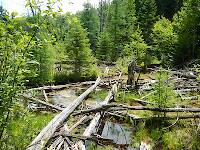

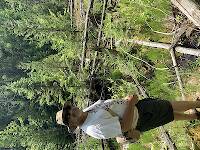
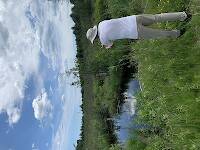
In the Photography Board by Jmd123
+ 15





In the Photography Board by Jmd123
1
Jul 8, 2020
by Martinlf
by Martinlf
16
Mar 2, 2010
by Martinlf
by Martinlf

